Welcome to Monte Giberto, a picturesque medieval village standing on a panoramic hill with a 360° view over the green hills of the Marche region and the splendid Marca Fermana.
Despite being a small municipality of about 800 inhabitants, Monte Giberto is rich in history, art, culture and a unique landscape, far from the hectic pace of the city, and with nature in many ways still unspoilt.
Its historic centre, with its quiet and authentic atmosphere, is well preserved and well cared for.
Strolling around, one can admire ancient churches rich in valuable works of art, narrow streets, small squares, well-preserved medieval walls, and the splendid Belvedere overlooking the enchanting territory of the province of Fermo.
Visit Monte Giberto, a picturesque village in the Marca Fermana
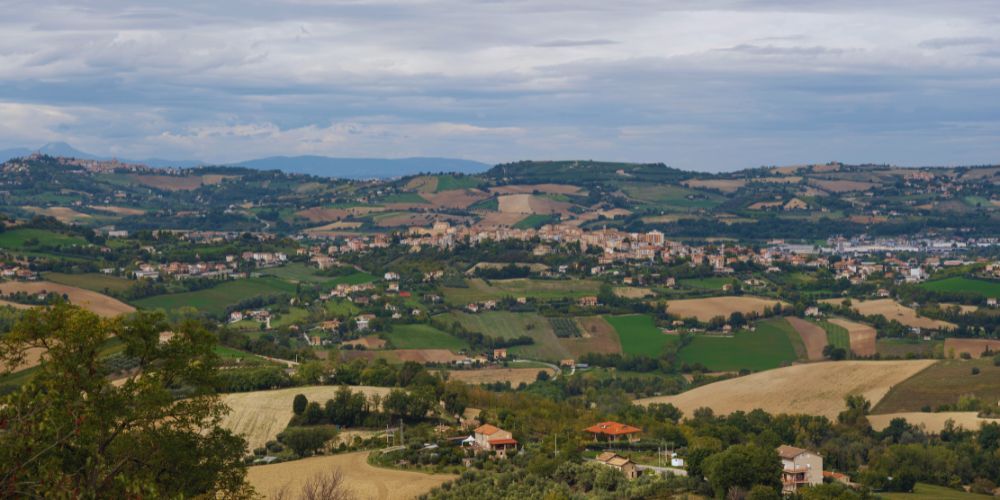
We are located in the so-called Marca Fermana, an area of great beauty and historical and cultural interest that coincides mainly with the province of Fermo.
This area is surprising for its variety and for the wealth of splendid panoramas that range from the Adriatic coast to the mountains, passing through gentle hills.
The particular characteristics of this territory allow the cultivation of a great variety of local products, which are then found in the tasty traditional dishes.
In fact, Monte Giberto's excellence is its rich eno-gastronomy, which you will find in the village's restaurants and typical shops.
Monte Giberto is the ideal destination for a journey of art, history, and nature. Travel at a slow pace and discover a still authentic territory of great beauty and unique views.
Visit Monte Giberto with us!

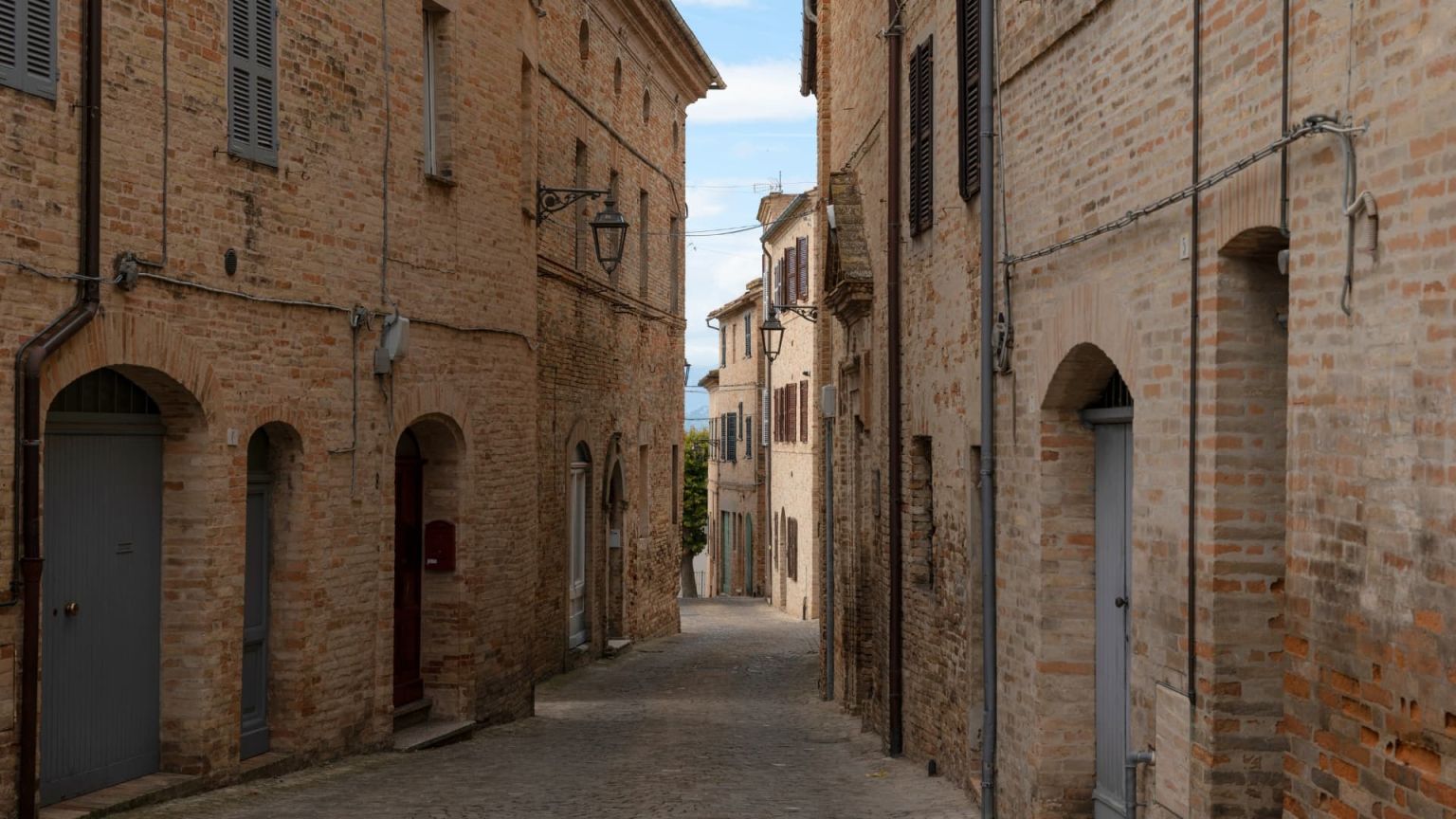

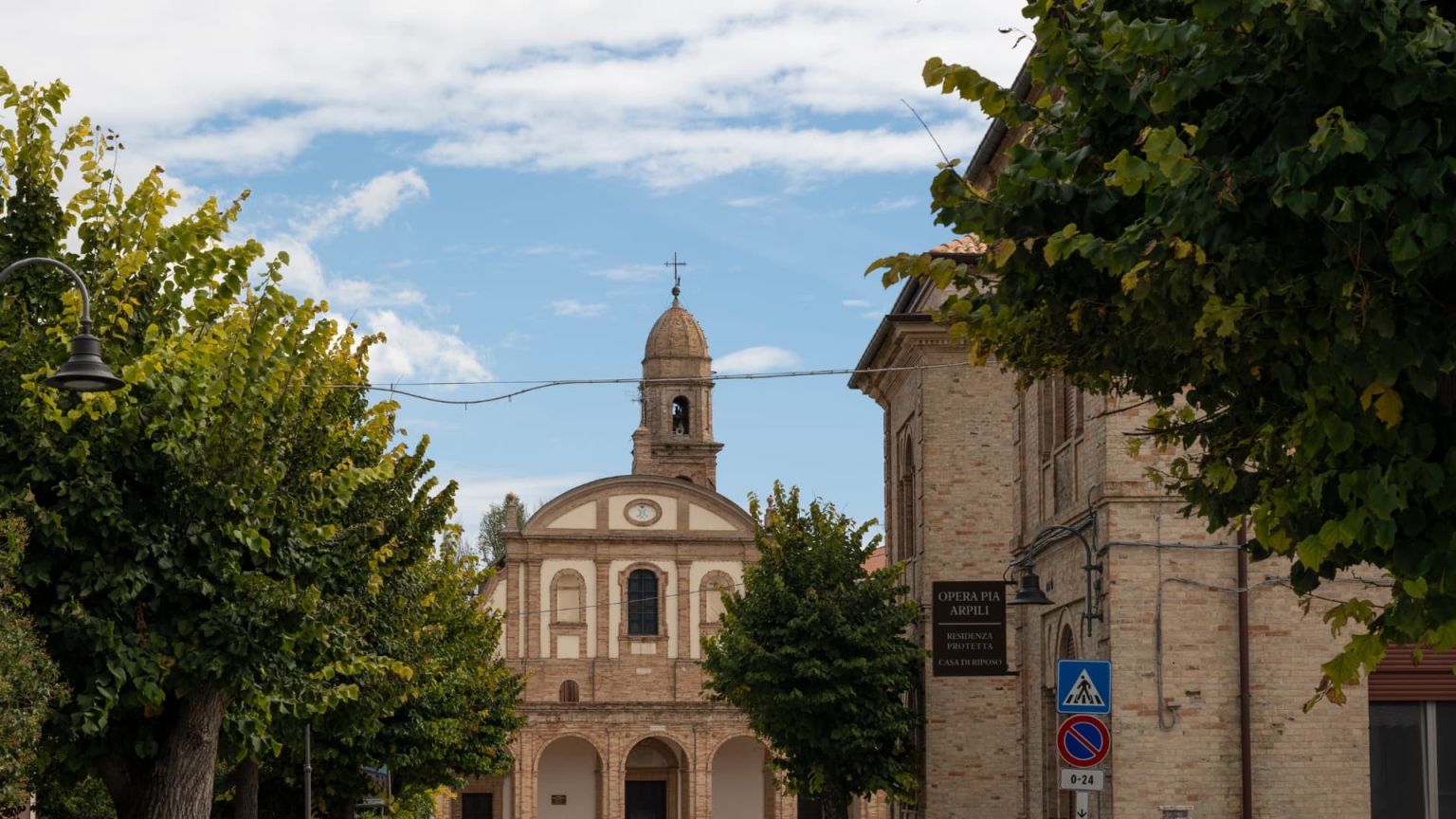
The history of the village of Monte Giberto
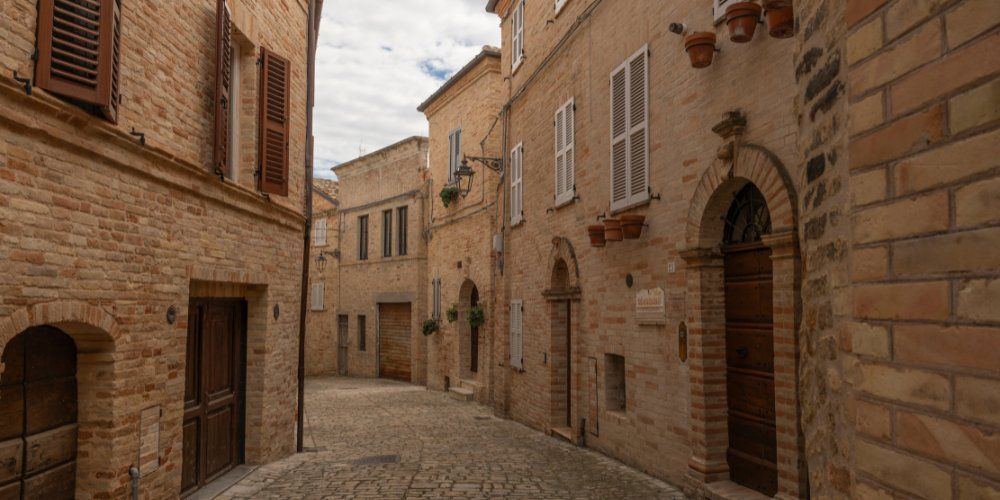
The history of Monte Giberto begins with the Picenes.
The Picens were an ancient population that inhabited the Marche region before the arrival of the Romans (43 BC).
During the Middle Ages, there were two castles in the current territory of Monte Giberto: the castle of Casale and the castle of Podio.
The first written source of settlements in the Monte Giberto territory dates back to 1166.
This document speaks of a certain Arnaldus Montis Giberti who, around the middle of the 12th century, became the owner of the hill where the ancient and small settlement of Monte Giberto stood.
The name Mons Giberti was also found in later documents. In fact, written sources confirm that Monte Giberto derives from the name of the powerful Picenian family, "Gibertidi".
At the end of the 13th century, Monte Giberto was described as a more established settlement, so much so that all the churches in the surrounding area referred to it.
The Descriptio Marchiae Anconitanae, a document written around 1356, at the time of Cardinal Egidio Albornoz, names Monte Giberto as "Castrum Montis Giberti" and includes it among the castles ‘towards the mountains’.
Castrums were fortified settlements with buildings and social life within the walls.
From medieval times until around 1830, Monte Giberto was governed by a podestà sent by the city of Fermo, and even in modern times, it remained under the control of the district of Fermo.
Written sources also tell us that in the 13th and 14th centuries, the ancient castles of Casale and Podio began to lose their autonomy and were absorbed by the new castle of Monte Giberto.
The fusion of the three castles into a single castle occurred in the 14th century.
Monte Giberto: a walk through the village
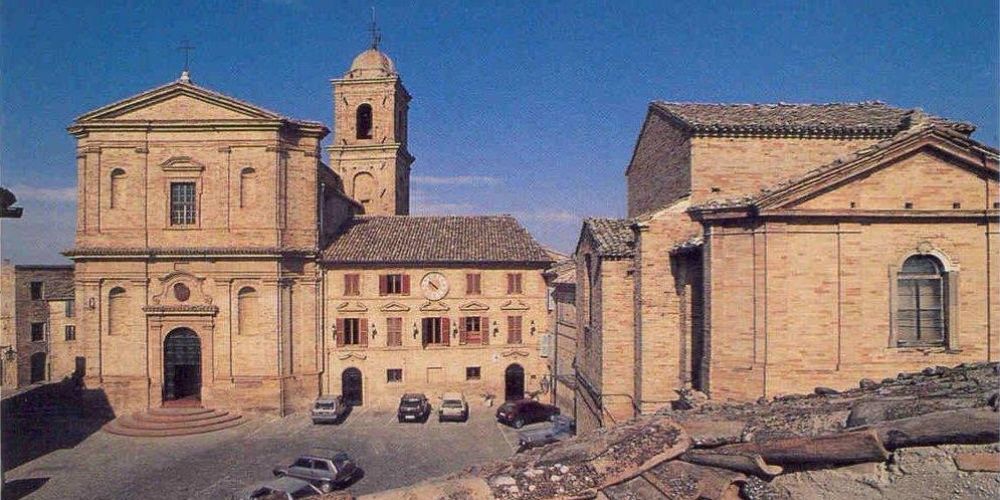
Stepping through the ancient walls of Monte Giberto will be like stepping back in time and immersing yourself in a magical and enchanting atmosphere.
Here, tranquillity is at home and the beauty of the land blends with architectural beauty.
The village still retains its medieval heart. You will walk through narrow streets, stone houses, ancient churches and noble palaces.
As you stroll through the hamlet, you will also observe the remains of the ancient medieval walls with its two towers.
Then you will reach the beautiful Belvedere, where you will enjoy marvellous views of the entire valley.
The village's heart is Piazza della Vittoria, which includes the church of San Nicolò and the Palazzo Comunale.
On the ground floor of the town hall (Palazzo Comunale) is the splendid Sala delle Volte that houses a fascinating permanent exhibition: the Siro Ciarrocchi Collection of Devotional Medals.
Continuing your walk, you will come across the beautiful 13th-century church of St John the Baptist, the small church dedicated to St Anthony of Padua and also the old communal oven with which, in the past, the baker Liso used to bake bread for all the families in the village.
A few steps from the village, you will also find the beautiful Sanctuary of the Madonna delle Grazie and the ancient Fonti.
Enter the churches of Monte Giberto and discover their valuable paintings and hidden treasures!
After a nice cultural walk, relax with a drink or a good lunch, and enjoy the peace and views of this village.
Explore Monte Giberto and the and the nearby villages with this tourThe Church of San Nicolò
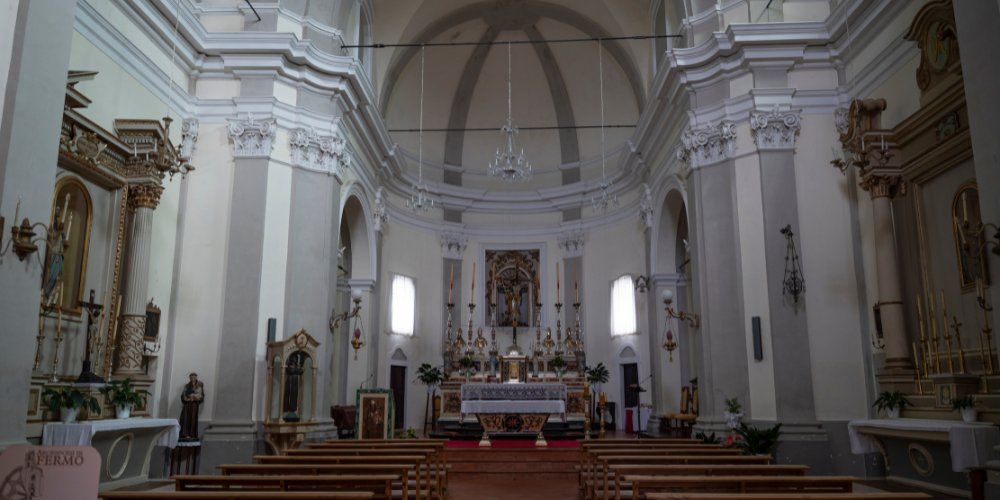
The Church of San Nicolò is located in the main square and is dedicated to the patron saint.
It was founded in 1090 and rebuilt in 1746 in neoclassical style, with elements of the late Baroque style.
The internal structure has a single nave and side altars. The interior of this church contains paintings and other valuable items.
Behind the high altar is a statue of St Nicholas, carved around 1750, while on one of the side altars, you will see a statue of the ‘desolate’, the Madonna del Pianto, as well as a polychrome wooden model of the Holy House of Loreto, from the 18th century.
In the presbytery, you can admire Our Lady of the Rosary and Saints, painted in 1580 by an unknown but gifted painter, and the Last Supper, commissioned by the Confraternity of the Blessed Sacrament in 1602.
The other valuable canvases are Our Lady of Loreto and Saints and the Crucifixion with Saints Anthony and Giberto, where Giberto holds a Monte Giberto model.
This canvas dates back to 1771 and was probably painted by the Montegibertese painter Gilberto Todini.
Finally, the church of San Nicolò houses a precious organ from 1797 made by the famous organ builder Gaetano Callido.
The Town Hall and the Sala delle Volte
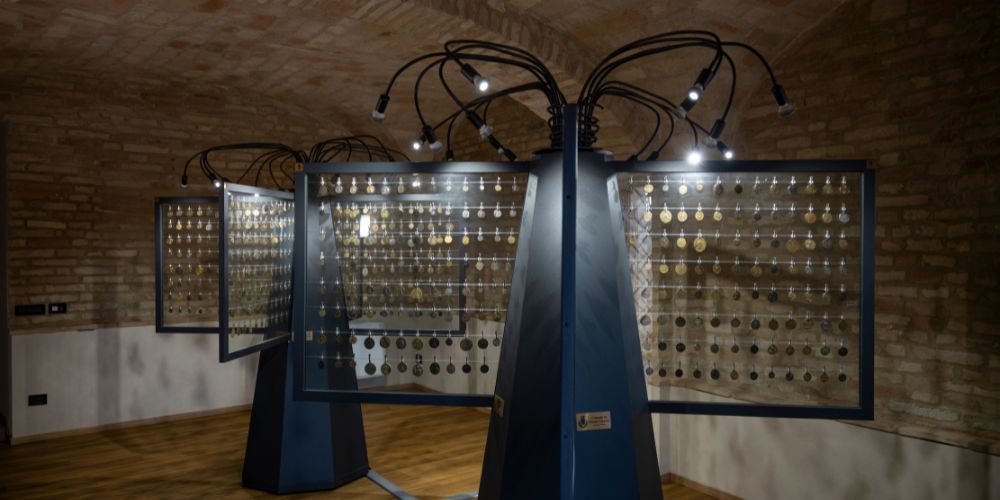
The Town Hall, in the central Piazza della Vittoria, is a 13th-century building with a bell tower and 18th-century elements on the façade.
On the ground floor of the Town Hall (Palazzo Comunale) is the splendid Sala delle Volte that houses a permanent exhibition of great historical and cultural value: the Siro Ciarrocchi Collection of Devotional Medals.
This Collection of Devotional Medals includes 10,000 medals from the 6th to the 20th century and was donated to the municipality by Siro Ciarrocchi, an inhabitant of Monte Giberto.
The medals are placed inside special displays made by local craftsmen and depict sacred subjects such as Jesus, the Saints and the Virgin, but not only.
This is a unique collection because of the number of medals collected and the particularity of the medals that do not only depict sacred images.
The Church of St John the Baptist
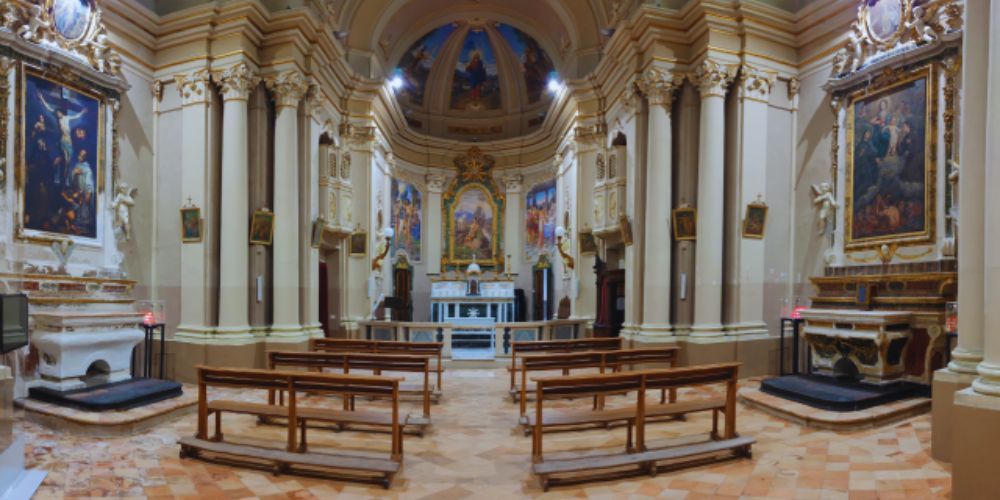
Among the other churches in the historical centre, a few steps from the Church of San Nicolò, is the Church of San Giovanni Battista, which dates back to the 13th century and was renovated in 1770 in the 18th-century style.
Inside are precious works such as some statues of Prophets in Baroque stucco and an 18th-century painting of the Madonna and Child, Saints and Souls in Purgatory.
The apse is finely decorated with frescoes depicting scenes from St John the Baptist's life. The church also stores a valuable organ made by Vincenzo Paci in 1876.
Admire the view from the Belvedere
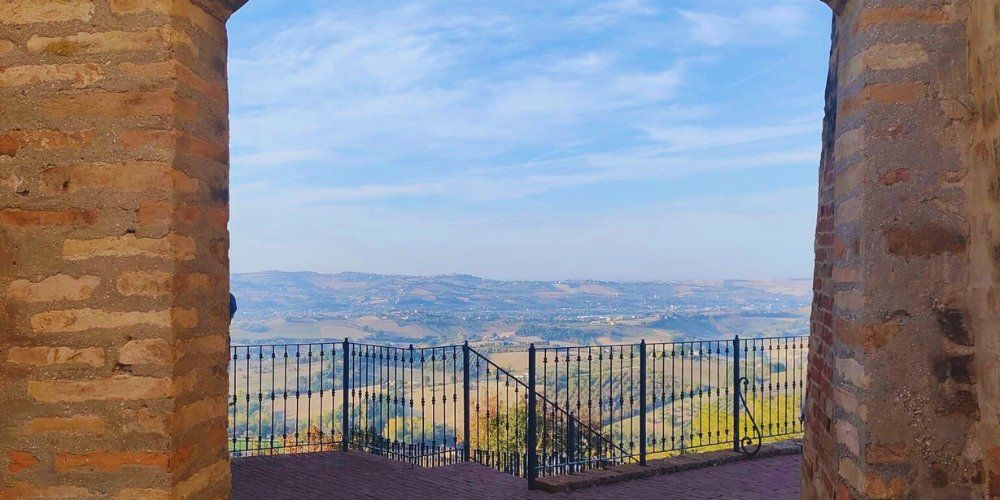
ph. credit: Federico Tassotti - fb page: Amici di Monte Giberto
Here we are in a romantic place for Instagrammable photos. Wandering through alleyways, between small squares and ancient buildings, you will arrive at a splendid balcony from where you can admire the vast panorama over the beautiful green hills of the Marche region, all the way to the sea.
Sun or moon, this is the ideal place to enjoy the atmosphere of the village and the enchanting view—possibly with a good glass of wine!
The Church of St Anthony of Padua
The Church of St. Anthony of Padua is the smallest of the churches in the historic centre of Monte Giberto.
It is located along the main street of the historical centre and was founded in 1742 by Angela Porti, a noblewoman from Fermo.
The style of the exterior façade is minimal. The main altar houses an 18th-century canvas depicting the Virgin and Saint Anthony.
This valuable painting was probably made by the well-known workshop of Ubaldo Ricci of Fermo.
The Sanctuary of the Madonna delle Grazie
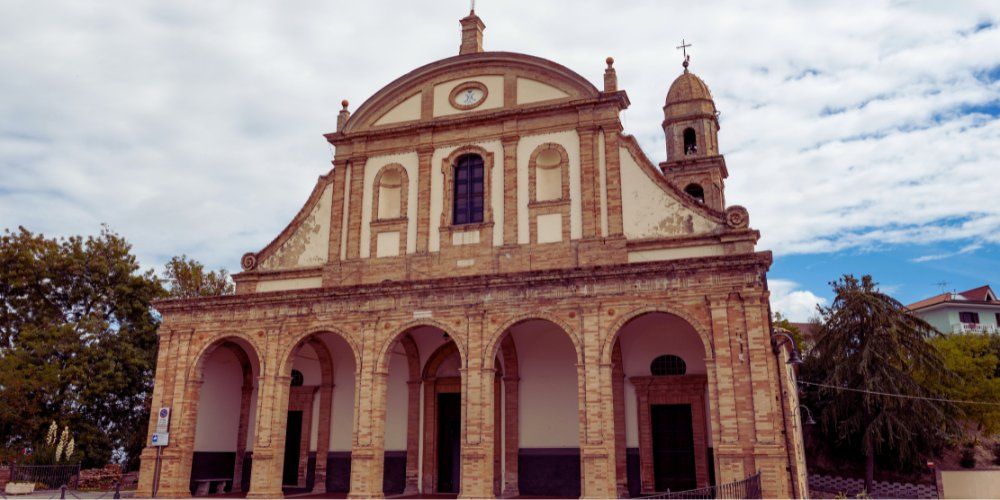
The Sanctuary of the Madonna delle Grazie is a few steps from the medieval walls. It is very dear to the inhabitants of Monte Giberto.
The present church, built in 1757 on an earlier 12th-century church, combines elements of the Baroque style with elements of classical taste.
Works of great artistic value are also kept in this sanctuary.
The high altar, inside a canopy, holds the precious statue of Our Lady of Grace to whom the shrine is dedicated.
Behind the altar, you will admire a valuable copy of the painting ‘Nativity of Mary’ by Annibale Carracci, now in the Louvre.
The apse is finely decorated with frescoes depicting Marian images, and another valuable organ made by Angelo Morettini in 1830 can be found in this church.
Sources tell us that miracles occurred in this Sanctuary between the 18th and 19th centuries. In fact, 8 September, the feast day dedicated to Our Lady of Graces, is very popular with the people of Monte Giberto.
The ancient springs
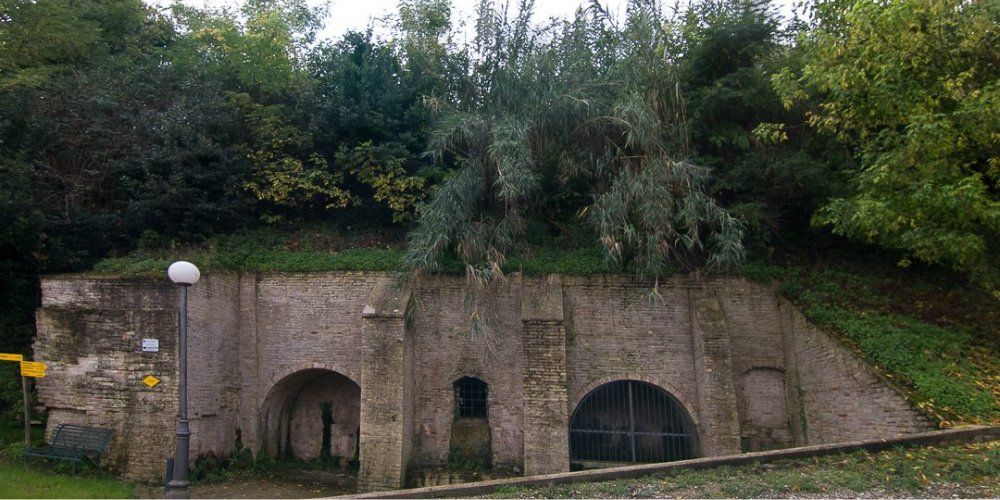
ph. credit: Maria Nives Urbinati Lucarelli - fb. page: Amici di Monte Giberto
In the vicinity of the Sanctuary of the Madonna delle Grazie are the ancient springs of Monte Giberto, evidence of the village's ancient history.
The village's ancient fountain presumably dates back to the beginning of the century.
Written sources tell us that around the second half of the 18th century, the population of Monte Giberto had great difficulty obtaining water as the public fountain was in poor condition, arid and unhealthy.
For this reason, a new fountain was built, and the existing spring was converted into a washhouse and drinking trough for animals.
Today, the well and a basin where the water from the well flowed are still visible. The old washhouse, originally located outside the structure, is no longer visible.
The illustrious personalities of Monte Giberto
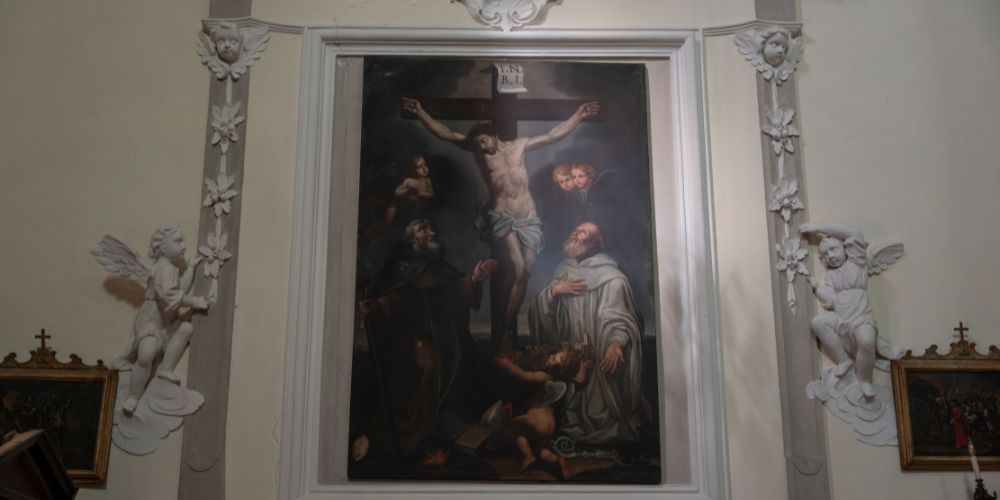
Gilberto Todini's painting - Church of San Nicolò - Monte Giberto
The small village of Monte Giberto has given birth to several prestigious men who, with their talent and commitment, have actively contributed to culture, art and local and national social development.
The first illustrious man we mention is Gilberto Todini, an esteemed 18th-century painter from Monte Giberto.
Todini was born in 1701 and was active until late in life. We can admire several of his valuable paintings in the churches of Monte Giberto.
His other important works are found in the churches of Fermo and other towns in the Marche region.
Gilberto Todini dedicated his life to painting, so much so that he produced one of his last works at the age of 97.
Another artist born in Monte Giberto in 1639 was Simone Palmieri, a well-known goldsmith and silversmith who obtained the important title of palace silversmith.
Let us now talk about a politician and man of letters born in Monte Giberto in 1806: Francesco Colvanni.
He was a politician, poet, and writer. He wrote poetry, inscriptions, and speeches with a political theme.
He worked hard in public offices and was also proposed as a candidate for mayor of Fermo.
Let us turn to two illustrious religious, Luigi Capotosti and Don Nicola Arpili, who were born in Monte Giberto in 1863.
Luigi Capotosti was a religious man with such a brilliant ecclesiastical career that Pope Pius XI made him a cardinal and gave him several important tasks.
A plaque commemorating the date of his baptism was placed in the church of San Nicolò, next to the baptismal font.
Don Nicola Arpili was an esteemed priest and rector of the shrine of Our Lady of Grace for many years.
Thanks to his generosity and commitment, we owe the purchase of the large bell and the renovation of the sanctuary's portico.
He is fondly remembered by the people of Monte Giberto for his generosity towards low-income people and for having founded the Hospital of Monte Giberto, later converted into a comfortable rest home.
Among other illustrious contemporary men, we recall the physician-neuropsychiatrist Massimo Fagioli, born in Monte Giberto in 1931.
After his studies, Fagioli worked in various psychiatric hospitals, and over the years, deepened his knowledge and experimented with new approaches to mental illness.
He wrote several books, taught at university and organised seminars on mental illness and its healing through modern and innovative therapies such as dream interpretation.
Traditional festivals and historical re-enactments
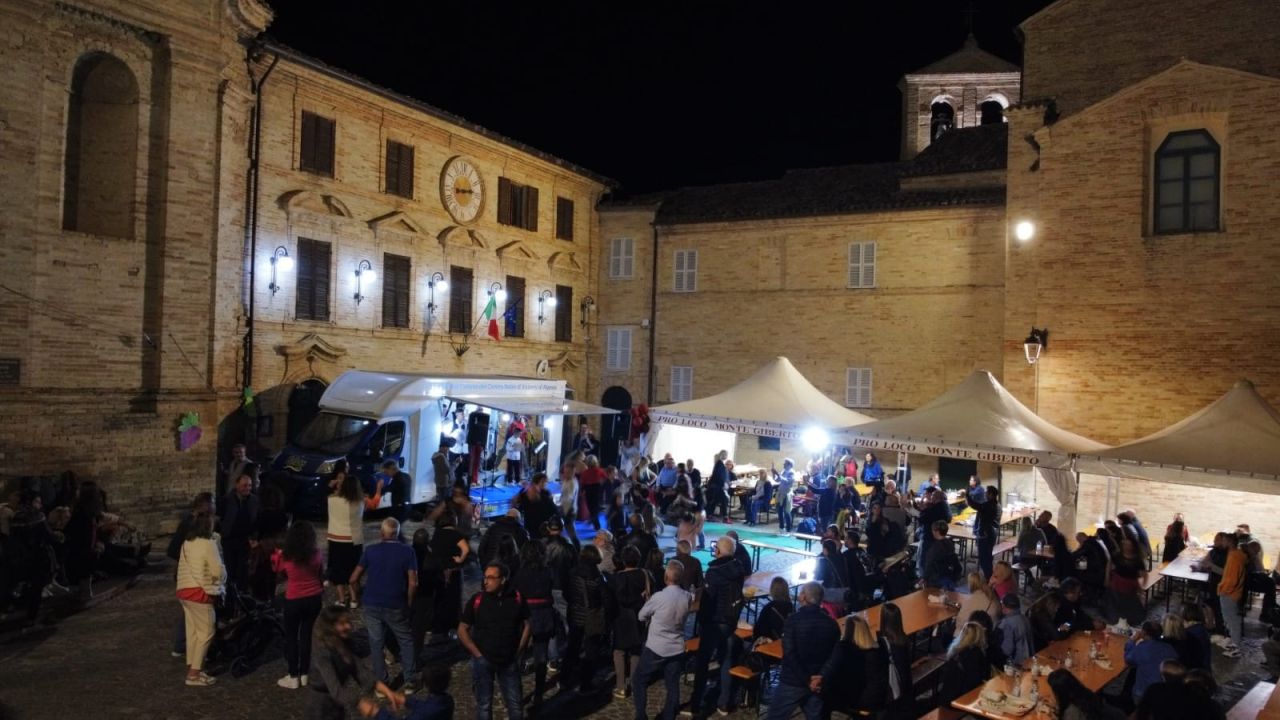
Various cultural events related to gastronomy, history and religion occur in Monte Giberto throughout the year.
These are special occasions for visitors to discover the ancient traditions of this territory.
Let's discover together the main traditional festivals and historical re-enactments that animate Monte Giberto.
In August, the Pinetina park hosts a festival dedicated to the Piceni, the ancestors of the people of Monte Giberto. The Piceni, who inhabited this territory before the Romans, are evoked through flavours and ancient rituals.
You can also participate in the Polenta festival and the historical re-enactment "de lo vatte" between August and September.
The historical re-enactment ‘de lo vatte’ is an interesting cultural event reminiscent of threshing, an operation carried out at the end of the cereal harvest, particularly wheat.
The very name of the event derives from the Marche word ‘vatte’, meaning threshing.
Vintage tractors parade through the village streets for this event and are blessed. Gastronomic stands offer the opportunity to taste the traditional dish that farmers used to eat at the end of threshing: Moccolotti de lo Vatte.
Moccolotti is a pasta similar to macaroni dressed with a nourishing meat sauce, usually goose.
If you prefer a good snack, you can choose a typical threshing sweet, such as "il ciammellottu" or "ciambellone de lo vatte", with a good glass of vin cotto!
September and autumn are perfect for a good plate of polenta, an ancient rustic food made from maize flour or other cereals, cooked for a long time in hot water.
At the polenta festival, you will enjoy polenta accompanied by traditional sauces and typical dishes, good folk music, and Stornellatori (folk poets-singers)!
The feast of the Madonna delle Grazie, which is celebrated on 8 September, is very dear to the people of Monte Giberto.
The celebrations include a solemn procession through the village streets, a fireworks display, and much entertainment and music in the square.
Finally, in October, we recommend the Autumn Festival, a weekend dedicated to gastronomy and local traditions.
A food and wine journey to discover the typical dishes of this corner of the Marche, entertainment shows, street artists and lots of fun!
Discover the local products and dishes
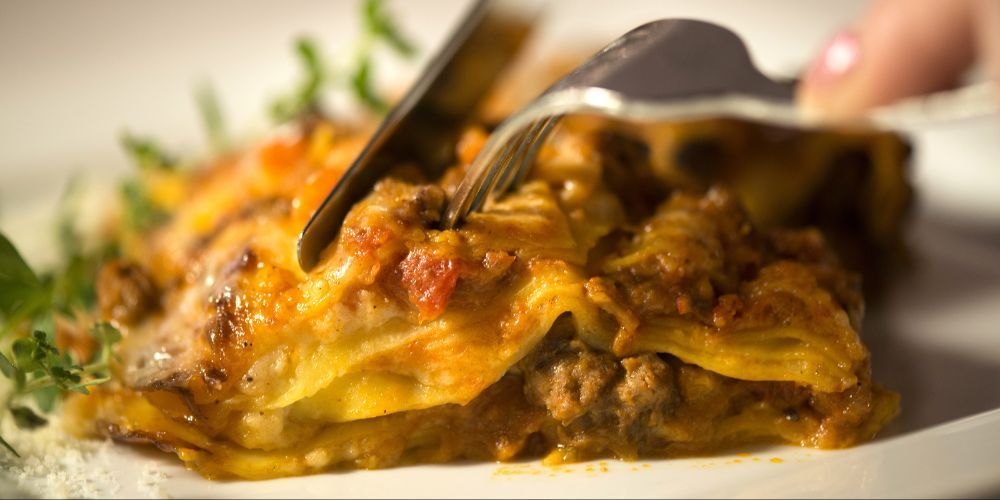
Vincisgrassi - typical dish of Marca Fermana - Photo credit: Di Daniele La Monaca - Own work
Monte Giberto is known for its exceptional products and gastronomy. The dishes of this territory reflect rural traditions and are made with genuine ingredients.
Jervicella wheat, a product of excellence discovered in the early 1900s in Monte Giberto, is a grain rich in fibre and protein with little gluten.
Thanks to its low gluten content, this wheat flour produces bread and light, easily digestible pasta.
Moreover, even today, the straw of Jervicella wheat is used to make traditional hats.
A typical dish of Monte Giberto and Marca Fermana is Vincisgrassi, a tasty lasagne variant made with tomato sauce, chicken entrails and different cuts of meat. It is a single dish prepared for important occasions.
One of the oldest traditional dishes is Frascarelli, or "rice in polenta". This dish is made of rice and flour and accompanied by a tasty sauce, often made with pork.
Other typical dishes include Polenta, accompanied by various condiments, and "lu pizzotto", a rough bread made with maize flour, sultanas and dried figs.
Finally, among the typical desserts, we mention "il Frustingo", a Christmas cake made with figs and dried fruit, dating back more than two thousand years.
We advise stopping at a restaurant in the village for a good lunch or dinner!
Parks and outdoor activities in Monte Giberto
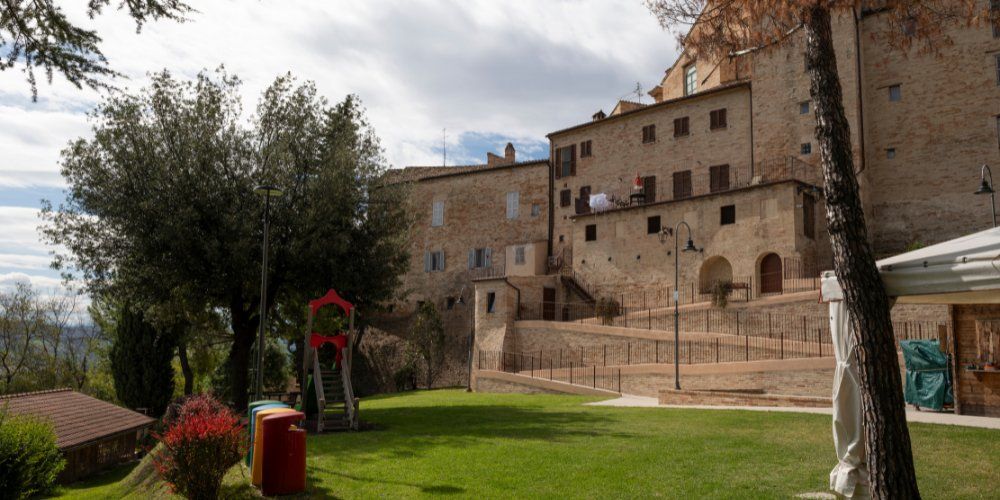
Perched on a hill, Monte Giberto is surrounded by greenery and nature. On its territory are two parks and a multi-purpose field, opened in 2021 for five-a-side football and tennis.
The Parco delle Rimembranze houses the war memorial. Every year, in November, the fallen of all wars are commemorated here.
Pinetina Park is a green area bordered to the west by the castle walls, overlooked by houses and the churches of St Nicholas and St John the Baptist.
This park also has a beautiful viewpoint that looks south and west.
The Pinetina is also a meeting place, especially in the summer and during the various traditional festivals organised by the municipality.
How to get to Monte Giberto
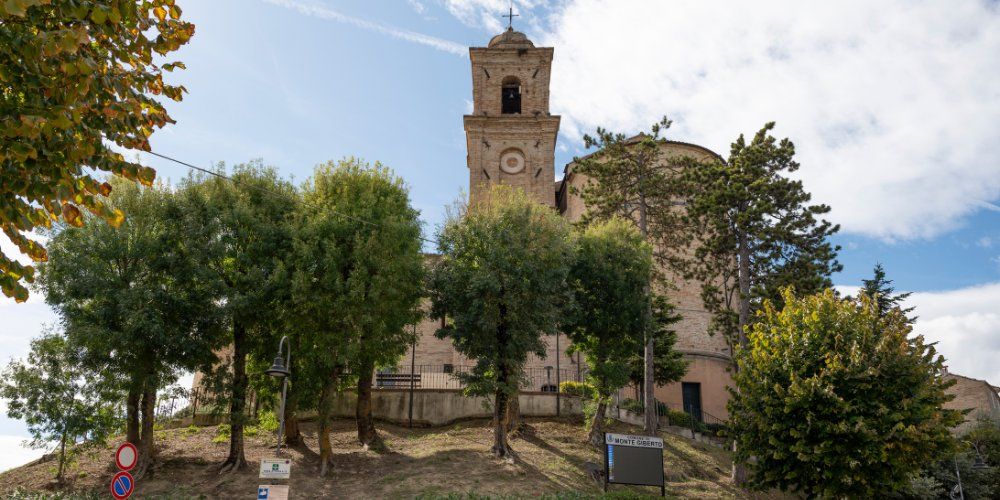
Monte Giberto can be reached by car or bus.
By bus: by local bus (Start plus Scarl line), from the Porto San Giorgio/Fermo train station.
By car:
Coming from the Adriatic A14 motorway (Bologna-Taranto), take the Fermo-Porto S.Giorgio or Pedaso exits.
Coming from the SS 77 Val di Chienti superhighway, take the Morrovalle - Monte San Giusto or Montecosaro exits.
The nearest airports are Ancona-Falconara (AOI) and Pescara (PSR).
The nearest international airport is Rome Fiumicino (FCO).




